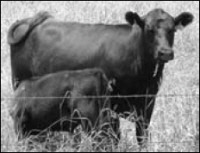



The Judicious Use of Antimicrobials for Animal Producers
By The Department of Health and Human Services, Minnesota University Extension. The production of safe and wholesome animal products for human consumption is a primary goal of beef producers.
To achieve that goal, producers should be committed to the practice of disease prevention through the use of vaccines, parasite control, stress reduction, environmental management and proper nutritional management. Responsible and timely management practices can reduce the incidence of disease and therefore reduce the need for antimicrobials; however, antimicrobials remain a necessary tool to manage infectious disease in beef herds. Prudent use of antimicrobials is important to reduce livestock pain and suffering as well as minimize losses due to disease. Furthermore responsible antimicrobial use will help minimize antimicrobial resistance in bacteria, which can impact animal health in your operation and the safety of food you produce.
Like other species, bacteria find ways to survive. Whenever bacteria are exposed to antimicrobials, some survive by developing resistance. Resistance depends upon the type and amount of antimicrobial used, the number of animals treated, and the length of treatment. Therefore, it is vital to use antimicrobials appropriately and judiciously in animals under your care.

Antimicrobial resistance concerns are shared by producers, veterinarians, governmental agencies, the public health community and consumers. Of particular concern is the risk of developing antimicrobial resistant bacteria in animals and the potential for subsequent human exposure. The antimicrobial resistant bacteria can, for example, be consumed by humans along with the meat product. Producers must be committed to appropriate and judicious antibiotic use in order to (1) minimize the risk of antibiotic resistant bacteria in animals, (2) maintain the long-term effectiveness of antimicrobials for humans and livestock, and (3) protect future antimicrobial availability.
Judicious Antimicrobial Use Guidelines
Producers do not stand alone in addressing this issue. Various veterinary groups have developed and adopted judicious antimicrobial use guidelines. These guidelines provide a road map for proper antimicrobial therapeutic use in livestock.
Prevent disease
- Prevent disease through management by emphasizing animal husbandry, biosecurity, and health maintenance. Antibiotic use cannot replace sound management practices.
- Appropriate and timely management practices include:
- Vaccinations
- Parasite control
- Stress reduction
- Nutritional management
- Environmental management
Diagnose sick animals
- Sick animals indicate a breakdown in preventative practices.
- Diagnose problems early and accurately.
- Many diseases have similar symptoms/signs.
- Not all diseases are treatable with antimicrobials.
- Use your veterinarian and a laboratory to help diagnose the problem.
Select appropriate antibiotics
- Use veterinary advice and laboratory results to help select appropriate antibiotics or treatment alternatives.
- Select and use antimicrobials carefully and only when justified.
- Develop written treatment protocols in collaboration with your veterinarian.
- Use the proper dose, given by the proper route for the proper length of time.
- Treatment programs should reflect best use principles.
- Treat the fewest number of animals possible.
- Withhold treated animals or animal products properly.
- Antimicrobial use, other than according to the label and, outside of a valid veterinarian-clientpatient- relationship (VCPR), is a violation of federal law.
Keep records
- Record animal or group identification, drug used, date treated, dosage used, route and location for administration, and who administered the product.
- Review records before marketing to ensure proper meat withdrawal.
- Keep and review records.
- “You cannot manage what you do not measure.”
How should this work on your operation?
Have a VCPROne of the basic principles of proper antibiotic usage is having a working relationship with your veterinarian, commonly called a VCPR. This means your veterinarian knows your operation, your management, your livestock, and is involved in diagnosis and treatment decisions. Your veterinarian must be available for follow-up in case of adverse reactions or treatment failure. This also means that you are willing to follow his/her instructions for antibiotic usage. A VCPR is not just having someone write a prescription, sell you drugs, or make them available to you.
The law requires a valid VCPR if an antibiotic is administered in any manner other than expressly stated on the label or the antibiotic is a prescription product. It is a good idea to get your veterinarian’s advice on the use of any drug in your operation.
A valid veterinarian-client-patient relationship is one in which:
(1) A veterinarian has assumed the responsibility for making medical judgments regarding the health of (an) animal(s) and the need for medical treatment, and the client (the owner of the animal or animals or other caretaker) has agreed to follow the instructions of the veterinarian; (2) There is sufficient knowledge of the animal(s) by the veterinarian to initiate at least a general or preliminary diagnosis of the medical condition of the animal(s); and (3) The practicing veterinarian is readily available for follow-up in case of adverse reactions or failure of the regimen of therapy. Such a relationship can exist only when the veterinarian has recently seen and is personally acquainted with the keeping and care of the animal(s) by virtue of examination of the animal(s), and/or by medically appropriate and timely visits to the premises where the animal(s) are kept.
Establish written protocols

A written protocol serves as a guide for on-farm diagnosis and treatment decisions. A complete protocol should include signs of the disease and detailed directions for treatment, including meat withdrawal times. You should establish written protocols for any antimicrobial use on your operation. These protocols must include your veterinarian’s input if prescription drugs are used or if drugs are used other than according to the label (extralabel use).
Extralabel Drug Use (ELDU)
Extralabel use means actual use or intended use of a drug in an animal in a manner that is not in accordance with the approved labeling. This includes, but is not limited to, use in species not listed in the labeling, use for indications (disease or other conditions) not listed in the labeling, use at dosage levels, frequencies, or routes of administration other than those stated in the labeling, and deviation from the labeled withdrawal time based on these different uses.
Understand what constitutes extralabel drug use (ELDU)
Drugs are approved by the FDA for treatment of specific diseases or conditions in a specific species or class of animal, at specific dose(s), route(s), duration(s), and frequency(s) of administration with a corresponding slaughter withdrawal time. Any use that deviates from the label instructions constitutes extralabel drug use and requires a valid VCPR.
An example of extralabel drug use is buying procaine penicillin G at a farm store and using it in cattle at a dose higher than specified on the label. The label dosage is 1 cc(ml) per 100 lb of body weight, but it is commonly used at higher dosages and/or given under the skin rather than in the muscle. These are extralabel uses, and it is important to understand that non-prescription drugs require a valid VCPR and appropriate labeling for extralabel use. Because approved withdrawal times are based on label directions, any other use may result in residues in violation of federal law.
Prohibited Extralabel Uses
The following drugs are prohibited for extralabel use in food-producing animals (current as of May 2002)- Chloramphenicol;
- Clenbuterol;
- Diethylstilbestrol (DES);
- Dimetridazole;
- Ipronidazole;
- Other nitroimidazoles;
- Furazolidone;
- Nitrofurazone; (
- Sulfonamide drugs in lactating dairy cattle (except approved use of sulfadimethoxine, sulfabromomethazine and sulfaethoxypyridazine);
- Fluoroquinolones; and
- Glycopeptides
An example of an illegal extralabel drug usage would be the administration of fluoroquinolones (e.g. enrofloxacin) to treat calf diarrhea.
It is illegal to use any feed additive drug in an extralabel manner in beef cattle.
Train people who treat livestock on your operation

People responsible for treating livestock must be properly trained to recognize common signs of disease as well as proper drug use and record keeping. Periodic and timely review of written protocols and treatment records with your veterinarian is the most effective method for ensuring judicious antibiotic use. Other sources of information regarding proper use of antibiotics include extension specialists, producer associations and pharmaceutical technical service representatives. However, recommendations for extralabel usage can only be obtained from your veterinarian.
Glossary
- Antibiotic—a chemical substance produced by a microorganism that has the capacity, in dilute solutions, to inhibit the growth of or to kill other microorganisms.
- Antimicrobial—an agent that kills bacteria or suppresses their multiplication or growth. This includes antibiotics and synthetic agents. This excludes ionophores and arsenicals.
- Antibiotic Resistance—a property of bacteria that confers the capacity to inactivate or exclude antibiotics or a mechanism that blocks the inhibitory or killing effects of antibiotics.
- Antimicrobial Residue—the presence of an antimicrobial at a level in meat or milk that is higher than levels established by the FDA.
Additional Sources of Information
- Your herd veterinarian
- Producer associations
- Extension specialists
- Pharmaceutical company technical service representatives
- FDA-CVM website: http://www.fda.gov/cvm/
- AVMA website: http://www.avma.org/scienact/jtua/default.asp



